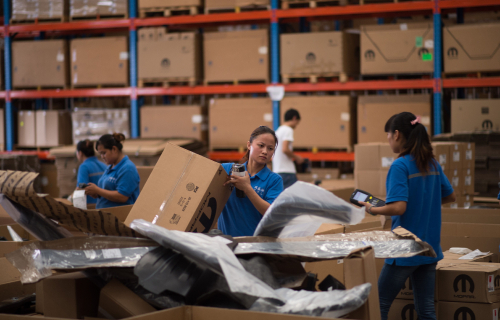|
 |
|
TRADING FREELY: Staff members work at a trading company within the China (Shanghai) Pilot Free Trade Zone. APEC is committed to promoting the liberalization and facilitation of trade and investment in the region (CFP) |
In terms of economic scale and the number of regions included, Asia-Pacific Economic Cooperation (APEC) is one of the world's three major regional cooperation organizations together with the EU and the North American Free Trade Agreement. The annual APEC Economic Leaders' Meeting holds great significance for both the region and the world. The Free Trade Area of the Asia-Pacific (FTAAP) will represent a hot topic during this year's meeting.
The FTAAP has been advocated for years. In 2004, the APEC Business Advisory Council submitted a proposal to the APEC Economic Leaders' Meeting, recommending the establishment of the FTAAP in the hopes of accelerating free trade process and facilitating APEC economies in resuming growth in the aftermath of the Asian financial crisis in 1997. APEC announced in 2006 that it would examine the long-term prospect of an FTAAP. The 2010 APEC Economic Leaders' Meeting confirmed that inroads had been made as regards forming the FTAAP, and the leaders' declarations announced after the meeting said APEC will further promote regional economic integration and take concrete steps toward the realization of such an area.
Basis and prospects
Asia-Pacific economies are imbalanced in terms of economic, social and political development. The United States lost enthusiasm for the FTAAP when it joined the Trans-Pacific Partnership (TPP) in 2010. However, explorations on economic integration in the Asia-Pacific region, with particular regard to the TPP and the Regional Comprehensive Economic Partnership (RCEP) started in 2012, have laid a solid foundation for the establishment of the FTAAP. Under current conditions, economic integration in the Asia-Pacific region is likely to advance through the TPP and RCEP, both of which will play important parts in the future FTAAP.
The TPP represents institutional cooperation featuring high quality and strong constraints, while the RCEP is a more oriental mechanism—voluntary, flexible, open and less institutional cooperation. The RCEP reflects the local experience of East Asian economies in long-term cooperation and is more suitable to the conditions of East Asian members; it is therefore well accepted and supported by East Asian economies. The TPP and RCEP could represent two complementary pathways to realizing the FTAAP. On one hand, they can finally realize the FTAAP. By 2025, the TPP will bring in $295 billion of annual benefits, while the RCEP will produce $500 billion of benefits each year. On the other hand, these two pathways provide more options to economies in the region.
If the FTAAP is established in the future, it will emphasize both constraints and mutual benefits to distinguish itself from the non-compulsory APEC. It will include super-WTO rules and pursue a high-quality free trade agreement. Covering the whole Asia-Pacific region, the FTAAP will reorganize all the existing bilateral and sub-regional free trade agreements. As a consensus among participating economies, the FTAAP is regarded as an important tool serving the Bogor Goals and facilitating economic integration in the Asia-Pacific region.
Facilitating free trade
Since the 21st century, developing and developed economies have debated trade issues. The outbreak of the global financial crisis in 2008 further gave rise to trade protectionism. Global multilateral trade systems represented by the WTO are short on the strength necessary to address these problems.
According to data from the Global Trade Alert, an independent monitor of policies that affect world trade, the number of cases involving trade protectionism has risen remarkably since the global financial crisis broke out, and in most cases, non-conventional trade protectionist measures have been adopted to avoid sanctions by the WTO. Further, protectionism-related measures such as trade remedies, export subsidies and discriminative government procurement are increasing, against which the current WTO framework has no effective measures.
| 